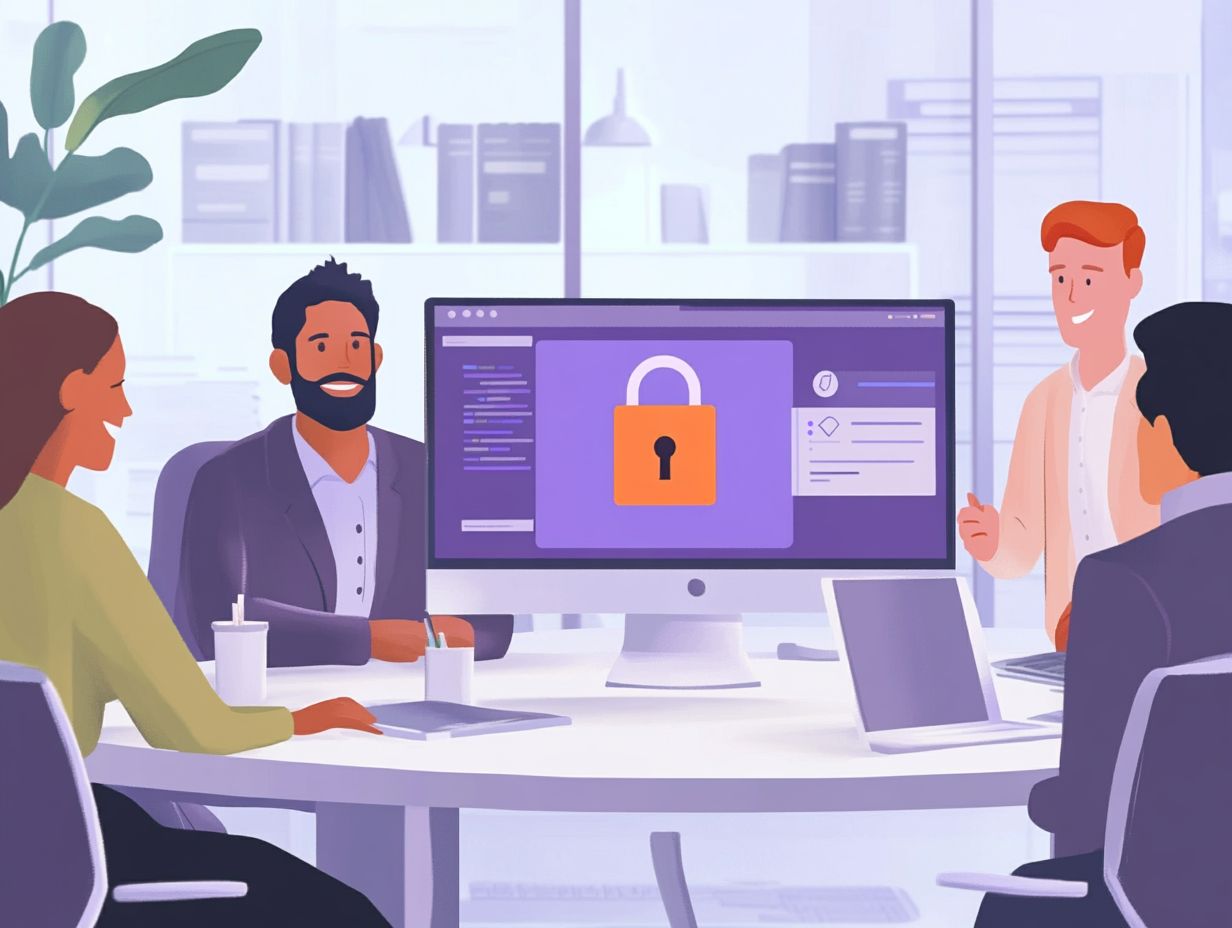In 2025, the landscape of cyber threats is continuously shifting, presenting fresh challenges for businesses, regardless of their size. To stay one step ahead, it is crucial to understand the most prevalent risks and how to prepare for them.
This article provides valuable strategies to assess cybersecurity vulnerabilities, implement robust protective measures, and highlights the crucial role of employee training in safeguarding your business through effective cyber threat mitigation and cyber defense strategies.
We delve into the influence of technology, the necessity of strong incident response plans, and best practices for securing sensitive data, including the integration of security protocols and cybersecurity frameworks. Furthermore, we explore the legal implications of data breaches, the importance of cyber insurance, and how to keep your business updated on emerging threats.
Arm yourself with the essential knowledge needed to enhance your cybersecurity strategy and protect your organization in this ever-evolving digital landscape.
What are the most common cyber threats businesses face in 2025?
In 2025, businesses face a wide range of cyber threats within the cyber threat landscape that threaten their operations and data security. Threats like phishing, ransomware, and malware are more advanced and present significant risks to companies of all sizes.
Understanding these threats requires staying proactive, as the cyber landscape continually changes with new technology and user behavior, emphasizing the need for continuous monitoring and risk assessment.
Phishing attacks now often use social engineering tactics to trick employees into giving away sensitive information. Malware, such as Emotet and ZeuS, shows how quickly and destructively software can penetrate systems. Ransomware attacks are particularly worrying, causing major financial losses and downtime for organizations.
Insider threats, often overlooked, can come from unhappy employees who deliberately compromise sensitive data, emphasizing the need for strict access controls.
As businesses navigate these challenges, awareness, cybersecurity training, and security awareness training are crucial to reducing vulnerabilities and protecting operations.
How can businesses assess their current cybersecurity risks?
To protect against cyber threats effectively, businesses should begin with a thorough risk assessment to identify weaknesses in their cybersecurity systems. By reviewing their IT infrastructure, performing security audits, and using threat detection tools, organizations can understand their current cybersecurity status and ensure they meet regulatory standards.
This proactive strategy enhances incident management and builds cyber resilience, resulting in a more secure environment with improved business continuity planning.
Beyond regular vulnerability management, businesses should use tools like penetration testing and risk assessment software to find hidden risks. Regular reviews ensure any regulatory changes are quickly addressed, maintaining compliance with standards such as GDPR or HIPAA.
Employee training programs can help develop a security-conscious culture, highlighting the importance of these assessments in building strong cybersecurity practices. A detailed risk assessment approach not only reduces threats but also improves the organization’s ability to respond quickly to any incidents.
What cybersecurity measures should businesses implement in 2025?
In 2025, businesses need a comprehensive cybersecurity plan that includes firewalls, encryption, and two-factor authentication to protect against cyber threats. These measures are essential for securing sensitive data and maintaining safe networks.
Companies should focus on endpoint protection and keep antivirus software updated to fight malware and other threats, including social engineering attacks.
Firewalls block unauthorized access by monitoring and controlling network traffic, which is a critical component of network security and security architecture. Encryption keeps intercepted data unreadable without a decryption key, crucial for transmitting sensitive information. Two-factor authentication adds security by requiring a second device to verify a user’s identity, making unauthorized access harder.
Endpoint protection systems watch network-connected devices to detect and respond to threats in real time. Best practices involve training employees to spot phishing attacks, regularly updating security software, and frequently auditing systems for weaknesses.
This combined strategy strengthens security and builds trust with clients and stakeholders.
How important is employee training in preventing cyber threats?
Employee training is crucial for preventing cyber threats by giving staff the skills to identify and handle potential security breaches, thereby strengthening digital security and cyber hygiene. In 2025, organizations need to invest in thorough cybersecurity training programs that build security awareness and good cyber practices among employees.
Practical activities like phishing simulations can strengthen a company’s defenses and lower the chances of a successful attack due to human error.
Effective training encourages a vigilant culture where every employee knows their role in protecting sensitive information. Regular updates to training content are necessary to keep up with the changing cyber threat landscape.
Awareness efforts, like monthly newsletters or interactive workshops, can reinforce what’s taught in formal training. Employees stay more engaged when they can connect learning to real-world situations. Adding game-like elements to training can improve retention, making security knowledge practical and actionable.
What role does technology play in protecting against cyber threats?
Technology plays a key role in protecting businesses from cyber threats, using advanced tools for threat intelligence platforms and automated security solutions. By 2025, organizations will rely more on network monitoring and new security technologies to identify and address potential weaknesses in real-time.
This approach streamlines incident response and improves overall cybersecurity, providing strong protection against various cyberattacks.
With automated security tools, firms can constantly monitor their networks, quickly spotting unusual activities that might signal a breach. Threat intelligence platforms offer important insights into new threats and attack trends, helping organizations to actively adjust their defenses.
These technologies form an essential protective layer that supports cloud environments and digital infrastructure, keeping sensitive data safe from unauthorized access and leaks. This comprehensive strategy helps businesses efficiently reduce risks and encourages a proactive security mindset among their teams.
How can businesses create an effective incident response plan?
Creating an effective incident response plan is essential for businesses to improve their cyber resilience and ensure quick recovery from potential cyber incidents. By 2025, organizations should develop detailed incident management strategies with clear security protocols and procedures for handling various cyber threats.
Implementing strong threat detection measures and establishing recovery guidelines can help minimize downtime and maintain business continuity during a cyberattack.
Organizations should tailor their response plans to address specific vulnerabilities and risks relevant to their industry, employing threat modeling and security metrics. This focused approach helps identify critical assets and prioritize incidents that could significantly impact operations.
Regular testing, such as simulations and tabletop exercises, sharpens the response team’s skills and helps identify and fix any gaps in the plan, supporting effective security incident response.
As cyber threats evolve, organizations must regularly update their incident response strategies to stay effective against new tactics used by cybercriminals.
What are the best practices for securing sensitive data?
Protecting sensitive data is critical for businesses in 2025, as breaches can cause serious financial and reputational harm. Using practices like encryption, strict access controls, and secure passwords is crucial for safeguarding data privacy.
Companies should invest in data loss prevention solutions to keep sensitive information safe and comply with regulations.
Regular security audits and employee training are key to maintaining a strong data protection strategy. By identifying vulnerabilities through audits, businesses can manage potential risks before they grow. Training employees to recognize phishing attempts and follow data handling policies strengthens security further.
Complying with regulations like GDPR or HIPAA helps avoid penalties and builds trust with customers and stakeholders, protecting the organization’s reputation and market position, while emphasizing cybersecurity audits and cyber liability management.
How often should businesses update their cybersecurity policies?
Businesses should regularly update their cybersecurity policies to adapt to changing threats and comply with relevant regulations. In 2025, it is recommended that organizations review their security protocols at least annually or whenever there are significant changes in their IT infrastructure or operations.
Regular updates improve risk management and ensure cybersecurity measures stay effective against new threats.
Besides annual reviews, businesses should assess their cybersecurity frameworks and security governance to respond to evolving cybercriminal tactics. This approach helps identify potential vulnerabilities early.
Incorporating feedback from employees and security assessments can improve the effectiveness of these policies. Companies should also have ongoing training programs to promote security awareness, ensuring staff can recognize potential threats.
By focusing on continuous improvement, security resources, and staying vigilant, businesses can create a strong cybersecurity posture that meets compliance requirements and reduces risks in digital operations.
What are the legal implications of a data breach for businesses?
The legal consequences of a data breach can be severe for businesses, including fines, legal liabilities, identity theft, and damage to reputation. In 2025, organizations need to follow complex cybersecurity and data privacy laws to reduce risks from data breaches.
Understanding their responsibilities and possible liabilities is key to creating effective compliance plans and considering cyber liability insurance to protect against financial losses. Implementing security policies and regular security audits can further enhance business protection and ensure compliance with regulatory requirements.
In today’s interconnected world, a single security incident can lead to thorough investigations by regulators, resulting in large penalties and class-action lawsuits from affected customers or partners due to data breaches, phishing attacks, or malware infections.
To protect themselves, companies should develop a strong data protection and cyber defense strategy that includes:
- Regular risk assessments and vulnerability assessments
- Employee training
- Effective incident response plans and incident management techniques
Investing in cyber insurance can offer financial support in case of legal action, helping manage expenses related to data resolution, digital forensics, and fines. It also aids in mitigating business risks associated with cyber threats and security breaches.
By staying vigilant and prepared through continuous monitoring, security awareness training, and implementing security best practices, businesses can significantly lower their risk of facing legal challenges from data breaches and security breaches.
How can businesses stay informed about emerging cyber threats and ensure cyber resilience?
Staying informed about new cyber threats is crucial for businesses to maintain strong cybersecurity. In 2025, organizations can use threat intelligence, network monitoring, and security frameworks to understand the changing threat landscape. Promoting security awareness, ongoing education, and implementing cybersecurity frameworks helps businesses prepare for cyberattacks. Additionally, conducting regular security audits and employing advanced persistent threats (APTs) monitoring will enhance their defensive measures.
Subscribing to threat intelligence reports offers actionable insights and helps organizations anticipate and defend against new vulnerabilities. Regularly reviewing industry news keeps companies updated on the latest trends, tactics, and software vulnerabilities used by cybercriminals. Working with cybersecurity experts helps develop a comprehensive defense strategy, promotes threat modeling, and encourages valuable knowledge sharing.
Most importantly, ongoing employee training, security awareness programs, and implementing effective password management and two-factor authentication ensure that the workforce stays alert and able to identify and respond to threats, strengthening the organization’s overall cybersecurity. Regular security incidents reports and updates on security metrics will also play a critical role in maintaining a robust security posture.




